The demand for quality and unique images is showing steady growth. With this, the popularity of stock photo websites is also increasing; there are already more than 30 of them around the world. One of the leaders in the stock photo market, Shutterstock, is anticipated to reach “$262.1 million in the current fiscal quarter (2025),” reported by Nasdaq with reference to Wall Street. But how do you develop a profitable website like Shutterstock? Is it a worthy idea in 2025? Here’s what our article is about.
History of the Stock Photo Market
The stock photo market, as we know it nowadays, has an extremely interesting history, starting from the emergence of the first photo cameras up to content digitization and further AI transformation. Now, let’s explore.
-
The 1920s-1930s: The Rise of the Photo Stock Era
Since photography was new, the primary attempts to create a so-called stock image-selling model belonged to H. Armstrong Roberts. Roberts took a photoshoot on the plane, asking everyone involved to sign the model releases, enabling him to sell the image later.
By the 1930s, Otto Bettmann saw potential in selling photography prints, so he collected 15,000 images on different themes to create the Bettmann Archive. Based on the card index system, the Bettmann Archive enabled business companies to refrain from hiring photographers to apply ready-made images by bringing cost-effectiveness and time convenience.
-
The 1980s: The Rise of the Stock Market
In 1980, agencies such as The Stock Market hired professionals to get preliminary photoshoots focusing on the client’s behavioral patterns. So the representatives could premake catalogs, knowing what the public would pay for.
As the technologies were evolving, there was an opportunity to use the image per the rights-managed license. The client paid for the billboard or a book cover for a predetermined duration based on a predetermined payout.
-
The 90s: CD ROMs, Floppy Disks, and Royalty-Free Licenses
In the 90s, stocked photos entered the era of digitization, enabling organizations like Photodisc to transmit images to floppy discs and CDs.
Photodisc revolutionized the stock market with its Royalty-Free license. The buyers could pay a flat rate and indefinitely utilize the stock images.
-
The 2014: The Rise of NFTs
Since 2014, the emergence of non-fungible tokens has affected the stock market considerably. In particular, NFT is anticipated to mitigate the issue of copyright infringement.
Photocentra, a decentralized NFT photo marketplace, ensures the creation of digital licenses for the content the users can distribute for illustrative and commercial uses.
This digital license represents irrefutable proof of the legal use of the purchased photo by preserving the owner's property rights.
The Impact of AI on Stock Photography
The outburst of AI in 2023 significantly reformed digital content within the last few years, raising considerable concerns in the stock photo market.
First of all, advanced AI tools can easily remove watermarks by preserving the image's high quality. This raises concerns about copyright infringement and seeking legal and technical countermeasures.
-
DALL-E
DALL-E offers unique image-making capabilities with its in-depth mimicking of artistic and photography styles. Moreover, this AI tool presents clear commercial rights for the crafted images.
-
MidJourney
MidJourney boosts user capabilities in image-making by granting freedom in fingertip customization. The user can alter posture or attire to align the final version with their vision fully.
-
Stable Diffusion
This AI tool generates high-quality images, enabling the user to have a decent degree of control over the output. Due to the inpainting element, Stable Diffusion can add or replace parts of generated photos, bringing more customization to the user experience.
Overall, the rise of AI places the following concerns in the photo stock market:
-
Copyright infringements
-
Legal issues with defining image authenticity
-
Revenue disruption
-
Quality competition
Shutterstock History
Although Shutterstock is a globally recognized brand of stock images, it’s quite intriguing how the business started till its transformation into a well-known empire. Let’s explore how it all began.
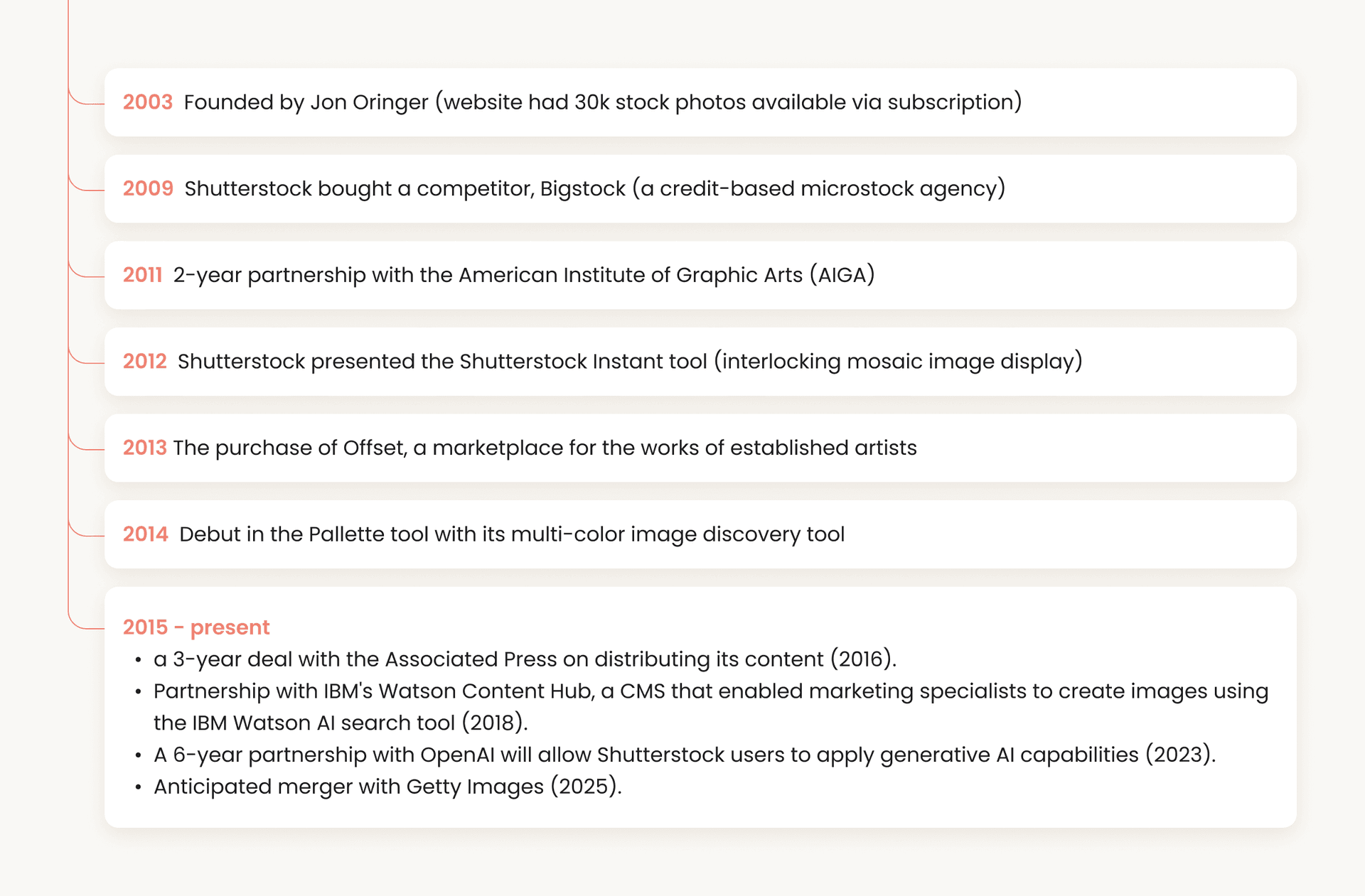
Hence, as you can see, the most significant elements of Shutterstock’s success include an emphasis on technological advancements and partnerships with versatile industry masterminds to boost competitive advantage and authenticity.
Shutterstock Business Model
Shutterstock applies a two-sided marketplace business model that links photographers and videographers with clients to promote high-quality content. Additionally, the AI-integrated recommendations enable users to narrow the scope down and find the most relevant content effortlessly.
Additionally, the platform keeps evolving, now offering Shutterstock Editor and Shutterstock Premier, to not only focus on simple content licensing but to increase customization capabilities.
Extra Monetization Tips
When thinking about engineering websites like Shutterstock, consider adding multi-sided monetization streams. For instance, the analyzed site relies mainly on subscription plans and on-demand purchases.
You can provide clients with the opportunity to make individual purchases for those who are not interested in subscriptions, as well as include versatile subscription tiers for downloading images and other relevant content.
Additionally, don’t ignore enterprise solutions, as Shutterstock ensures custom licensing and API integration to streamline corporations’ access to high-quality images.
Why You Should Start a Stock Photo Website Business
Tailoring a stock photo website like Shutterstock is worthy of attention, considering the transformative power of digital content. With the growing demand for social media, versatile businesses seek opportunities to connect their services with platforms like Instagram or Facebook to reach their target audience. Let’s present the benefits of developing a stock photo website focusing on the key stakeholders.
Market Visibility
The plethora of high-caliber digital content breaches geographical limits, enabling any global user or corporation to access the image they need. Content visibility and accessibility can significantly benefit the target audience, especially those with budgeting constraints. Based on low operational costs, digital content distribution does not rely on traditional inventory, making the images fast, accessible, and affordable.
Competitive Advantage
Don’t forget that the rise of AI requires reshaping the traditional approaches to serving digital content. Integrating Artificial Intelligence can be time-effective, considering the search for the required image parameters, including theme, style, and disposition. Automated tagging can boost image promotion by assigning it to relevant keywords. Finally, integrating smart recommendations per user behavioral patterns can reinvent the essence of stock image business by automatically presenting personalized content.
Now, let’s categorize the benefits of stock photo websites for the major stakeholders:
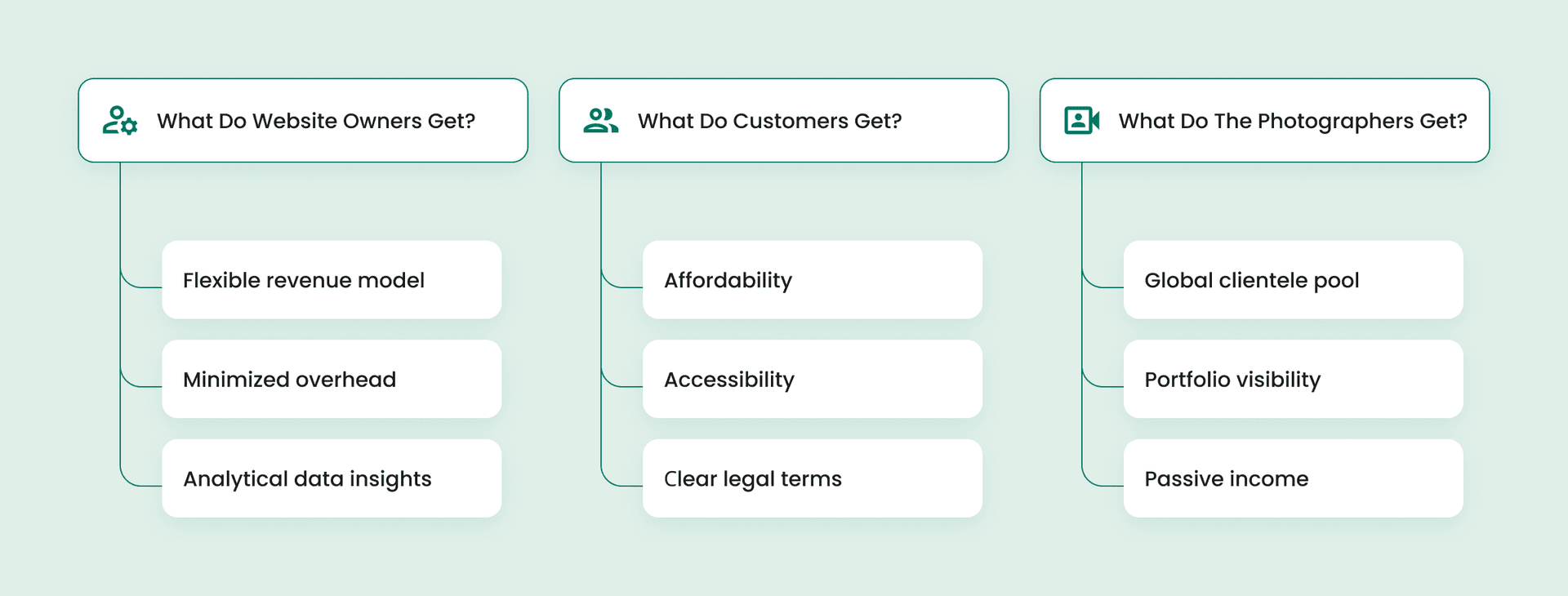
What Do The Website Owners Get?
-
Flexible revenue model
The business owner can benefit significantly by implementing multiple monetization models such as instant purchase, premium, etc., which will cover the whole spectrum of clients’ preferences, offering the option that will suit their demands perfectly.
-
Minimized overhead
Business owners don’t have to bother with logistics expenses, as the digital nature of stock photos is about the seamless and rapid nature of content delivery.
-
Analytical data insights
As the stock photo website represents a hub of versatile digital artworks, business owners can be on the same page with trends, providing clientele with proprietary tech tools and virally-themed content.
Additionally, the owners can operate with the data pool to analyze the consumer's overall behavioral patterns, such as preferences, time spent on the website, to provide personalized offers further or reshape content distribution.
What Do Customers Get?
-
Affordability
Stock photo content represents a cost-effective alternative to traditional personalized photoshoots.
-
Accessibility
Stock photo websites refrain from the traditional library image categorization, providing clients with rapid access to the versatility of thematic images.
-
Legal terms
Stock photo websites can erase user concerns on the legality of the used content by presenting clear legal conditions for personal and commercial use.
What Do The Photographers Get?
-
Global clientele pool
The photographer can kill two birds with one stone, as by uploading their content to the stock photo website, they don’t have to run business relations with individual clients.
-
Portfolio visibility
Photographers can present their artworks to a global audience, preserving their authorship, which simplifies the visibility of their portfolio among the global photography community.
-
Passive income
The photographer can gain passive revenue from the same image based on the number of downloads or instant purchases.
How to Make a Website like Shutterstock
But how to develop a website like Shutterstock in practice? Let’s clarify.
Define Your Business Model
The primary step in tailoring a stock photo website like Shutterstock is selecting the appropriate business model and integrating it into your business plan. This matters to ensure a seamless revenue stream. Here is a short breakdown of the essential monetization models:
Microstock vs. Macrostock
Microstock operates a royalty-free license (in some cases, an extended license) for image distribution. Its core features include:
-
Low price
The price for the royalty-free license may start from $1. However, note that the client can own the license, which gives them flexibility in image usage, not the image itself.
-
Purchase & Use duration
Instant purchase with unlimited time of purchased content use.
-
Transferability
License reselling is prohibited, which indicates the license ownership rights by the person who committed the purchase.
-
Exclusiveness
Microstock images are available to any user, regardless of the motives of their usage (e.g., commercial use or website promotion).
Note that royalty-free license images can encounter two labels: editorial and commercial. These labels represent the cases of usage allowance.
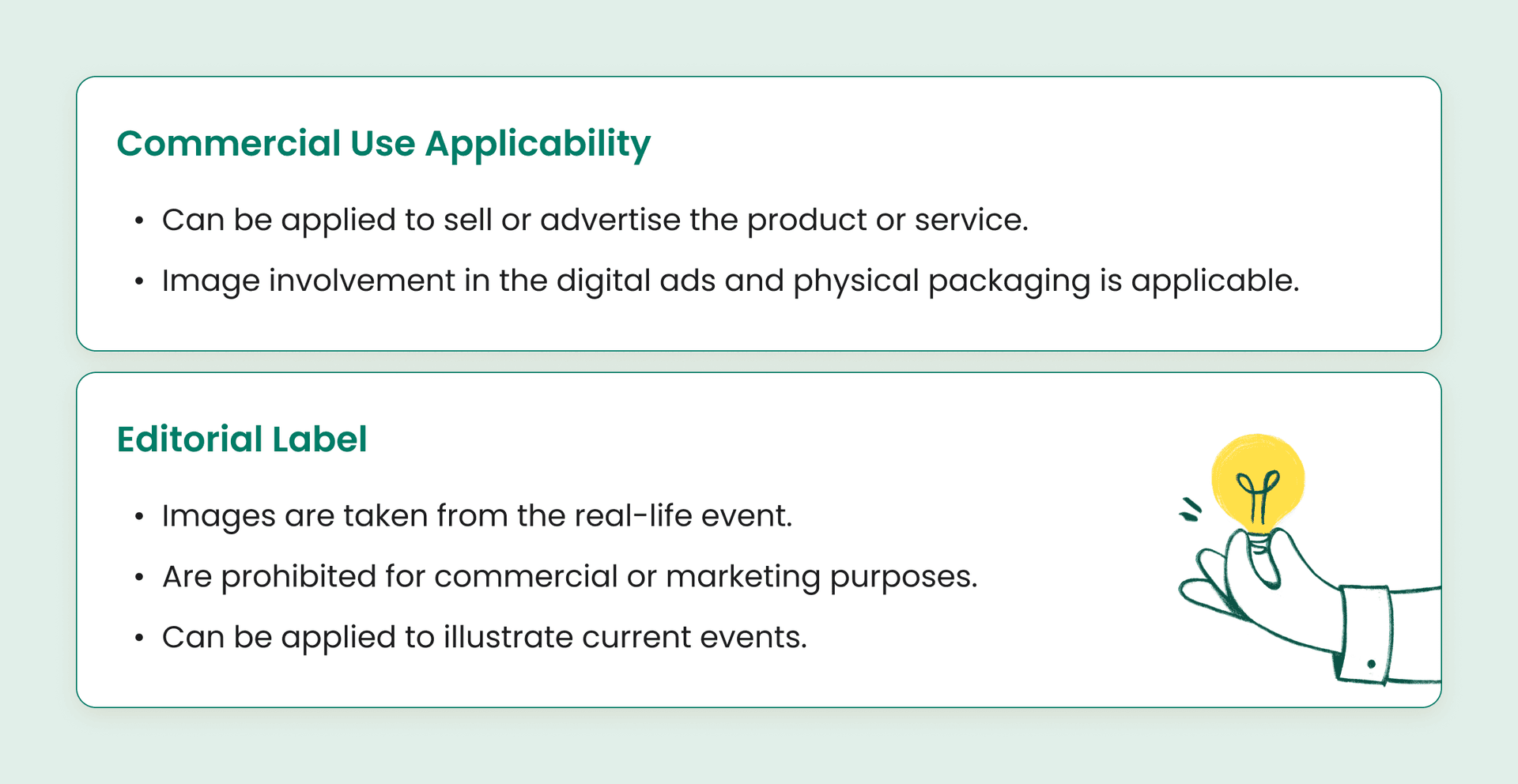
The extended license relates to ‘some kind’ of the additional opportunities of the royalty-free license. Unlike microstock, which limits the time your customer can reproduce the item, the extended license does not restrict the reproduction time. Reselling this license is not prohibited. Finally, purchasing the extended license brings some degree of exclusiveness as once sold; the image is taken out from the repository, which means no one after your client can purchase the license for the image. However, note that users who bought the license before them can access the image and use it as they please.
Macrostock
Macrostock or rights-managed stock image license is more restrictive than the royalty-free license as it imposes the following use standards:
-
Geographical restriction
The image can be used only on a specific area.
-
Number of reproductions
Unlike the extended license, macrostock model sets the limitations on the use number.
Macrostock operates images of high-caliber quality but does not provide complete exclusiveness in image utilization, as this model supports selling licenses but for a limited number of people.
Subscription vs. Pay-Per-Download
The subscription model implies selling images based on recurring payment initiatives. The subscription tiers can be basic, professional, and enterprise levels, which define the monthly number of downloads and accessibility to the photo library. The subscription model operates standard licensing for downloads within the subscription period.
The pay-per-download model does not impose subscription obligations, enabling users to purchase the images they need right away. This model can implement the credit system, where the users purchase a number of credits that can be exchanged for the images. Note that the per-per-download model can impose dynamic pricing, where images of different sizes and quality can differ in price. Finally, this model can incorporate discounts for bulk downloads, making it convenient for corporate use.
Although the presented models demonstrate different angles of monetization opportunities, why not consider a hybrid business model? The advantages of such a decision include:
-
Clientele coverage
The users are likely to prefer your stock photo website per the availability of models they can adhere to when using the images.
-
Risk prevention
Multiple revenue streams can back up the website, ensuring its financial stability.
-
Revenue flexibility
The abundance of business models promotes the maximized coverage of the versatility of market segments.
Key Features of a Stock Photo Website
Building a custom stock photo website like Shutterstock might be a challenge. That’s what we’re for here - to break down the development process and simplify your comprehension. Here is the list of features you need to take into account.
Contributor Profiles & Submission Process
These intertwined elements relate to the photographer who’s gonna contribute content to your stock photo website. From this, the feature must incorporate portfolio management, an upload interface, and an analytics dashboard.
-
Portfolio management enables content creators to displace their artworks to bring public visibility.
-
Upload interface to simplify uploading and processing of multiple images.
-
Analytical dashboards. Don’t ignore this element, as it directly relates to the photographer’s performance tracking and analysis of their revenue. The failure to implement an analytical dashboard might cause the loss of contributors.
Buyer Accounts & Licensing Management
The fundamental elements of client’s account creation and management will include:
-
Authorization function.
-
Profile information (user name, contact info).
-
Preferences (settings, preferred language).
-
Payment method (saved info on client’s pinned credit/debit card).
-
Collections (the ability to save the preferred content via the website).
-
Plan (applied if you integrate the subscription business model).
-
Transparent documentation on image licensing (based on the monetization model you integrate).
A few words to consider about license options and management. If you consider implementing a hybrid monetization model, you’ll have to ensure seamless license checking and tracking from both client and business management perspectives.
-
License types. This element implies a clear definition of license types (extended, royalty-free, rights-managed, subscription-based). Additionally, this element requires defining restrictions and allowance in use.
-
Use tracking. This feature refers to the business functionality as it checks the ways the images and licenses are used to prevent cases of content/license manipulations.
-
Expiration monitoring. This element matters from both business and client perspectives, as it sends automatic notifications for renewal of time-limited licenses (especially in the subscription business model).
Advanced Search & Filtering
Remember to bring the maximized convenience and searching capabilities within your stock photo website. Therefore, the opportunities such as:
-
Keywords search.
-
Filters (search by color, size, theme, ethnicity, style, etc.).
-
Image-based search (ML integration for searching required content by image).
-
AI-powered search (an advanced feature that enables users to receive images of the highest quality based on API-based search capabilities).
Storage & Content Management
Consider the highest scalability in photo storage—implement cloud-based storage options, which will benefit the library's expansion.
Additionally, content versioning should be integrated to generate different variations of images, which is a convenient function for content creators.
CDN incorporation might be beneficial to streamline content delivery and security by significantly reducing the time for distributing the image preview, while the original variant is preserved via the server.
Intellectual Property & Copyright Protection
Maximized legal security for all stakeholders involved must be a top priority for the stock photo website creation:
-
Set watermark system. Watermarks represent a decent combative strategy against unauthorized content use.
-
Incorporate image fingerprinting. Image fingerpriting relates to a so-called digital signature of the artpiece to ensure tracking the usage of the downloaded content.
-
Set download tracking system. Why not enabling your systems monitor all downloads to check whether the user abidance by the license is preserved.
-
Integrate DMCA compliance tools to handle takedowns on copyright infringement effectively.
The Digital Millennium Copyright Act (DMCA) is a copyright law that prevents the illegal reproduction and spread of copyrighted content. Therefore, all websites that upload content are obliged to be DMCA-compliant.
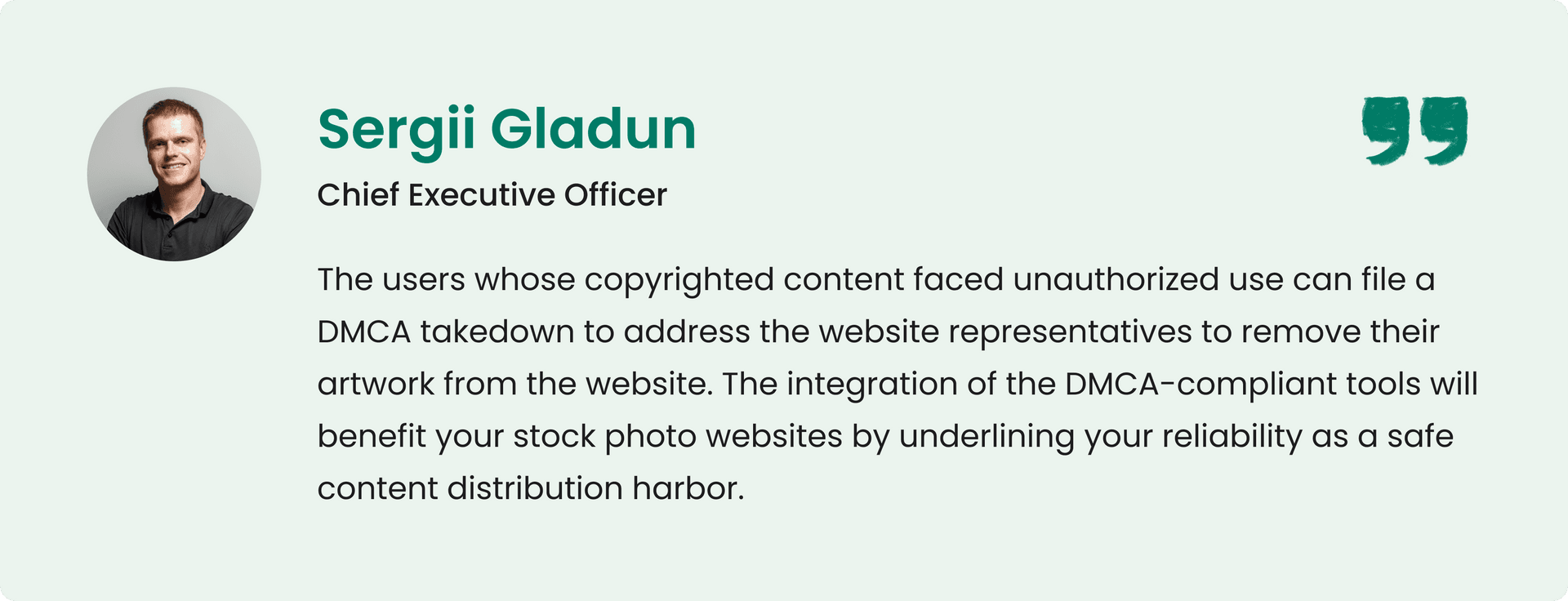
Security & Data Privacy
Security and user/contributor data privacy represent the factors of no-less importance in crafting a stock photo website like Shutterstock. That’s due to the frequent payment fraud attempts and cyberattacks that can intercept content transmission. In order to ensure the highest level of safety, consider the following:
-
Integrate SSL encryption to ensure a fully-fledged and secure coverage of data transmission regarding the encompassing user activities.
-
Ensure GDPR privacy compliance to promote lawful and confidential user data preservation.
-
Abide by the PCI-DSS compliance standards. This security measure matters as when handling payments, your website will have to make sure that the cardholder’s sensitive data are safe based on the PCI level assigned to your business.
AI-Powered Image Tagging & Enhancement
This feature is a must in the era of AI advancement as it can significantly optimize the overall content distribution through:
-
Automated tagging for formulating keywords (to optimize search).
-
Content recognition is used to simplify and accelerate content categorization.
Email & Notification System
Finally, implementing a notification system will get the user updated on their activity and payment-relevant actions.
-
Implement system notifications to inform the user and content creator about the account-specific activities.
-
Integrate automated alerts on payment confirmation or failure cases.
Technical Aspects & Development
The practical development process requires selecting an appropriate technology stack and analyzing payment processing and website architecture.
Choosing Technology Stack

Frontend Development
React.js ensures the developmental capabilities for further seamless operation of the following website functions, such as lazy loading for optimized image management. Additionally, the mentioned framework is applied to state management to alleviate the coverage of the states through things such as shopping carts or image selection.
Material-UI can benefit stock photo website development based on the pre-buit elements including card components and dialogue windows. The card components enable showcasing image previews based on pre-designed components. The dialogue windows promote image previews as well and license-relevant data.
Backend Development
Node.js with Express.js can process images and downloads to ensure seamless request handling. Additionally, user authentication and license management can be supported by the RESTful API.
PostgreSQL is applied to handle data storage of structured information like license information and user accounts.
MongoDB is about handling unstructured data, such as image metadata.
Storage
Amazon S3 and Google Cloud Storage help process large-scale image repositories, ensuring versioning (image backup and recovery) and scalable storage (storage capacity optimization).
DevOps & Deployment
New Relic is applied to ensure a seamless analyzes users’ interaction with the image-relevant services and website’s response.
GitHub promotes the automated deployment of new features and bug handling.
Website Architecture & Scalability
Don’t ignore the website’s architecture and scalability; these elements will cover the overall image abundance.
The modular components of the website architecture will promote independent scaling for the website components, such as search, storage, etc.
Database optimization is another activity crucial to website architecture as it aims to manage the influx of image transactions.
When it comes to scalability, you can consider auto-scaling and horizontal scaling. The first option is applied to the real-time dynamic resource allocation. The second option involves involving additional servers to manage traffic increase.
Payment Processing & Monetization Options
The finishing touch of stock photo website development is integrating tech logic that would promote seamless payment handling.
Consider accepting multiple payment methods in payment gateway integration such as debit, credit cards, by now pay later option, and crypto wallets that will further assist in shaping clientele payment preferences.
 Learn more about how to integrate a payment gateway in the app.
Learn more about how to integrate a payment gateway in the app.
Integrate the options for notification about the subscription expiration and an automatic payment deduction to prompt the subscription’s functionality.
Additionally, you can experiment with discount management by setting a discount logic that would support different determined conditions. For instance, there are in-bulk purchases, limited discounts for season-themed downloads, etc.
Finally, tokenization should be considered as a security measure to streamline transaction safety. This option transforms payment info into tokens, so if the attacker attempts to intercept transaction processing, the info will make no sense.
The Cost to Develop a Website like Shutterstock
Speaking about the approximate cost of engineering a stock photo website like Shutterstock, it can range from $15000 to $25000+ with some extra maintenance expenses.
Now, let’s break down the approximate price range for creating a basic Shutterstock-like website.
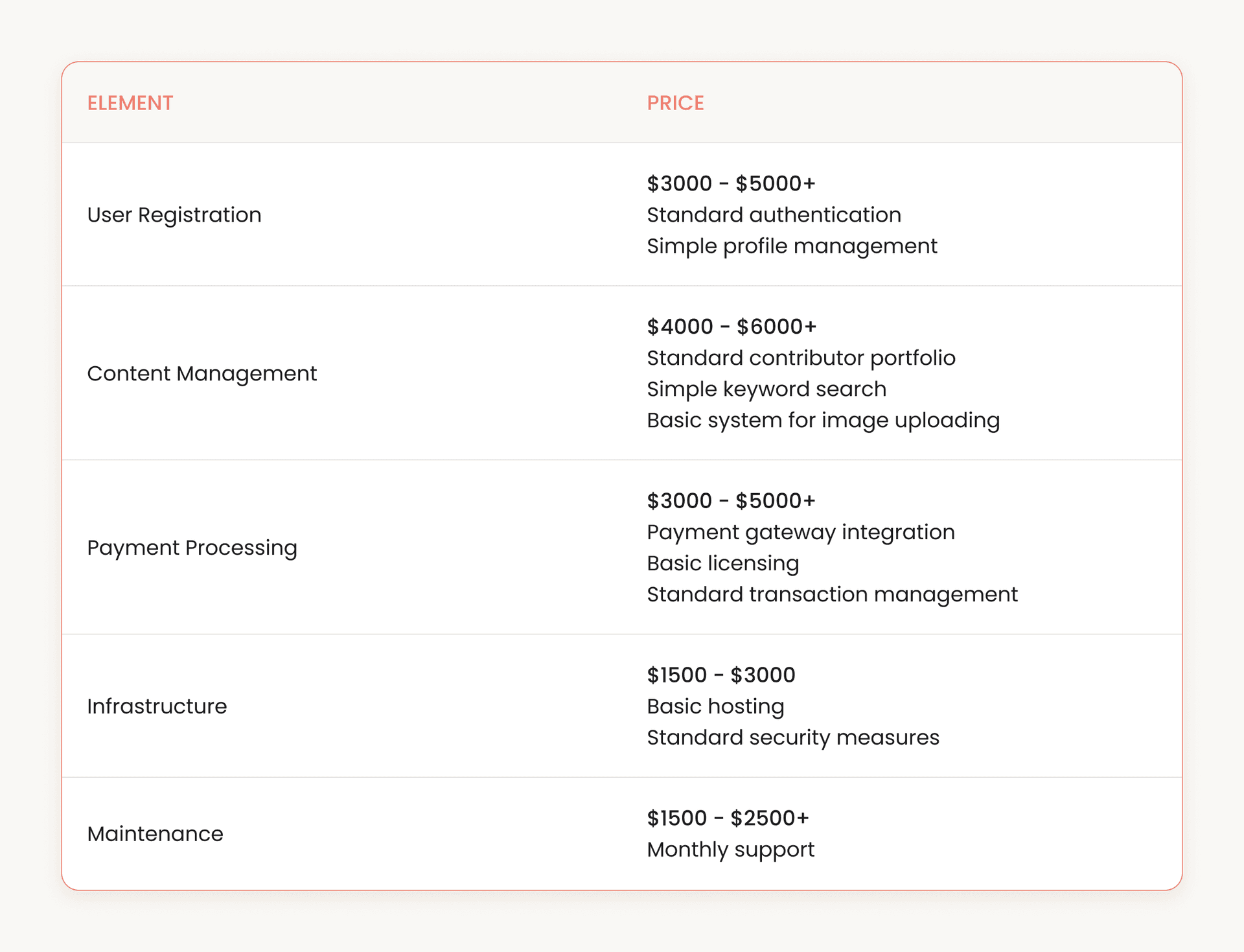
MVP Development
Don’t forget that MVP development is an essential step for website creation as it will present a minimal spectrum of elements to present a draft and simplistic version of the website.
MVP of Shutterstock-clone website will include:
-
Simplistic user registration (email authorization; support of the basic identity-relevant information for profile creation).
-
Content Upload (basic uploading with restrictions on size).
-
Manual Tagging and Basic Categorization.
-
Standard Keywords Search.
-
Single Payment Gateway Integration.
-
Basic Downloading Function (post-purchase image downloading logic).
-
Basic SSL Encryption.
-
Simple Cloud Storage Solutions.
How to Reduce the Cost of Stock Photography Website Development?
How to optimize resource allocation? That’s actually a reasonable question, considering the scope of tech elements needed to integrate for the seamless operational activity of your Shutterstock-like website. Why not think about the following?
-
Integrating open-source content management systems like WordPress.
-
Utilize analytical tools free of charge prior to utilizing premium variants.
-
Integrate outsourcing teams to cut costs associated with team and equipment maintenance.
 Take a look at the essence and models of outsourcing with a guide on its practical implementation.
Take a look at the essence and models of outsourcing with a guide on its practical implementation.
Extra Secrets of Creating a Site like Shutterstock
Why not implementing Artificial Intelligence into your stock photo website capabilities? Artificial Intelligence can be helpful with search optimization, enhancement of personalization, and content moderation.
AI can significantly boost the quality control of assessing image alignment with quality standards. You can integrate this technology to ensure automatic content categorization to minimize manual intervention. Additionally, consider integrating the search by image option so that the clients can search for unique licensed content of high quality to use in a legal and copyright-abiding fashion.
AI can significantly benefit your DMCA compliance by detecting inappropriate or copyrighted content to simplify removal.
Finally, you can consider integrating AI to ensure smart pricing, as this technology can assess the images and provide price recommendations based on their artistic uniqueness.
Other Successful Stock Image Market Players
The other no less successful stock image websites worth mentioning are Adobe Stock and Getty Images.
Adobe Stock
Adobe Stock is about versatility and flexibility as it integrates multiple payment options including subscriptions and credits for instant purchases. The royalty-free licensing combined with the plethora of images gives a large pool of content, effective, especially for commercial purposes.
Getty Images
Getty Images differs from Shutterstock and Adobe Stock based on its target audience selection. The distinctive feature of the platform is the high-caliber content provision for the enterprise-level segment, as well as professional users that leads to expensive pricing for premium material.
Build Your Own Shutterstock-like Platform with Agilie
As a European outsourcing IT organization, Agilie keeps crafting unique, sophisticated digital solutions encompassing the versatility of business needs. With the value of result orientation, our dedicated development teams strive for fully-fledged product excellence to elucidate our top-notch expertise in fintech, marketing, logistics, real estate, and other niches.
Here’s how Agilie can help you tailor a Shutterstock-like platform. We offer a significant spectrum of stock photo website-building services:
-
Mobile App Development (in case you want to have a cutting-edge application run seamlessly with the website version).
Summary
Creating a stock photo website represents a valuable business opportunity since it is necessary to produce unique and authentic content. In order to make a stock photography website like Shutterstock, you should consider its abidance with copyright laws and proper licensing to ensure your platform is a safe hub for digital content. Finally, pay attention to tech advancements, as their integration can significantly streamline your website’s operational performance.
 Wanna create a compelling photo stock website? Just contact us!
Wanna create a compelling photo stock website? Just contact us!
